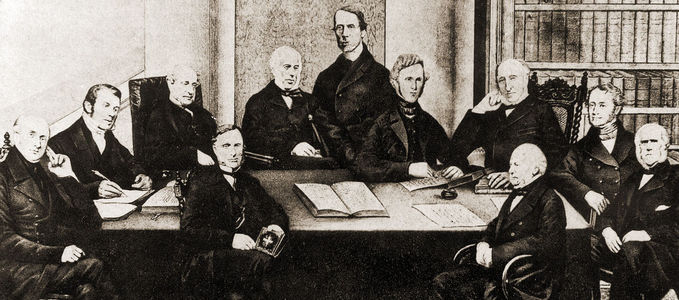On the way towards an active apostolate
Called and consecrated, but not yet separated: 14 July marks the anniversary of a milestone in the history of the Apostles in modern times. Read on to find out what’s with this date and what it means for the New Apostolic Church today.

The 14th of July is the second of three milestones on the way to establishing the apostolate. This is how it was explained by Thomas Carlyle, the Apostle of the Catholic Apostolic Church in whose tradition the apostolate was later continued in Germany. He compared the development with the threefold anointing of King David: through the prophet Samuel, through the tribe of Judah, and finally through all of Israel (1 Samuel 16: 13; 2 Samuel 2: 4; 5: 3). Carlyle considered the first anointing equivalent with the prophetical call of Apostles, the second anointing corresponded to the separation, and the third would find a parallel when the Apostles were sent out.
Desire for renewed activity
The history: Christians of different denominations desired a renewed outpouring of the Holy Spirit. They found what they were looking for in reports of miraculous healings. Representatives of the Prophetic School met to explore the Scriptures’ promises concerning the end-time—for example, in prayer circles or also at Albury, a conference hosted by the politician and banker Henry Drummond and the celebrated preacher Edward Irving.
Prophecies saw the lawyer John Bate Cardale as an Apostle of Jesus Christ, whose prophetic calling was acknowledged in September 1832 by Irving’s and additional congregations. On Christmas of the same year, Cardale carried out his first two ordinations as an Apostle.
Signs were fulfilled
Already at the start of the year 1832, 14 July 1835 was designated by prophecy to be a special event. At first it was thought to be the date for the return of Christ. Later it was interpreted to signify the founding of the apostolic movement, which gradually turned into an organised church. It was thought at the time that there should be seven churches in London as well as a group of twelve Apostles.
But even on the long-awaited day itself, two congregations were still missing: open-air sermons in the Paddington district of London and similar activities in the exclusive Westminster district resulted in the establishment of the two missing congregations. By the afternoon, however, there were only eleven Apostles. The twelfth Apostle did not want to accept the calling. Following the biblical example of the election of the Apostle Matthias (Acts 1: 15–26), lots were cast to decide between two candidates.
A church ruled by Apostles
All signs had been fulfilled. On the evening of 14 July 1835 each of the Angels (Bishops) of the seven churches in London laid his hands on each of the twelve Apostles, meaning that from then on the Apostles were “separated”. This meant that they were released from their duties in the congregations, and equipped and blessed for their future tasks: to lead the Universal Church that was just emerging.
Until they took over, the Apostles retreated for a period of study and preparation, assuming that only afterwards they would be “sent forth” to all Christians as the new twelve. But it was not to come this far, at least not the way they had expected it. The appeal of the Apostles to the clergy throughout the world to submit to the authority of the new Apostles—laid down in the Testimony—died away almost unheard. And two of the Apostles let their activities rest.
The split
Nevertheless, the British Apostles began with preparing the bride of Christ. Starting in 1847 they began to seal Christians in their respective working areas who had been baptised with water. Apostle Carlyle, who was active in Northern Germany, was very successful. It was also he who advocated that the number twelve be re-established. However, he could not assert himself in the apostolic college.
In the tradition of Apostle Carlyle, who died in 1855, the Apostolic Congregation and, finally, the New Apostolic Church emerged via various intermediate steps. That is why 14 July 1835 is also a significant date for the New Apostolic Church: “The New Apostolic Church understands itself as a continuation of the Catholic Apostolic Church,” it says in an official statement of the Work Group History. “Although the two churches clearly differ in terms of their organisation and their liturgy, they are bound by the certainty that the Apostles are essential for the preparation of the bride of the Lord, which is their common task.”
Photo: The Apostles of the Catholic Apostolic Church in a photomontage (without Duncan MacKenzie)




